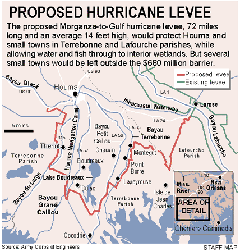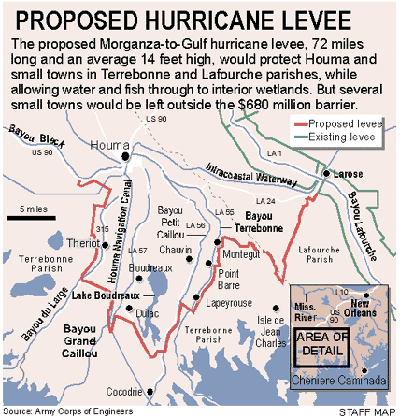New Orleans: Lessons Not Learned
Air Date: Week of August 24, 2007

Proposed Levee (courtesy: Army Corps of Engineers)
Two years after Katrina, New Orleans and coastal Louisiana remain vulnerable to catastrophic flooding. Host Bruce Gellerman speaks with Time Magazine’s Michael Grunwald about progress not made and lessons not learned by Congress and the Army Corps of Engineers.
Transcript
GELLERMAN: From the Jennifer and Ted Stanley Studios in Somerville, Massachusetts – It’s Living on Earth. I’m Bruce Gellerman sitting in for Steve Curwood.
[SOUNDS OF POUNDING RAIN]
It was just two years ago August 29th 2005 Hurricane Katrina took aim on the Gulf Coast of the United States.
WOMAN: Wow this is the eyewall we’re in the eyewall. Oh my god look at that… look at the storm surge coming in!
GELLERMAN: Katrina was one of the most powerful, costly and deadly storms to strike the United States. The most severe loss of life was in New Orleans 80 percent of the city was under water. But much if not most of the deaths and destruction were due not to the natural disaster but human failure. There have been three major engineering investigations into the city’s catastrophe. They generally agree that the New Orleans’ system of levees were poorly designed and built by the Army Corps of Engineers.
But Michael Grunwald a senior correspondent for Time magazine who covered the Corps for the six years before Katrina struck goes even further. He says the Corps and Congress are directly responsible for the disaster.
GRUNWALD: You know I think after Hurricane Katrina the levees broke. It was a split second and nobody was watching. And then for a week we got to watch this paralyzed response and everybody saw that. But the fact is that if the levees hadn’t busted, you never would have heard the phrase “heck of a job, Brownie.” You never would have had the squalor in the Super Dome. If the levees had been designed and constructed properly and the Army Corps of Engineers had done its job, it really wouldn’t have been a big deal for the city.
GELLERMAN: Well, your story in Time Magazine really is a scathing indictment of the Corps and you write that the Corps is still a Corps of engineers and not a Corps of ecologists. What do you mean by that?
GRUNWALD: Well the Army Corps is a strange beast. It began building fortifications at Bunker Hill in George Washington’s revolutionary army. But it’s really sort of it’s best known and what has been its bread and butter is sort of damming and diking rivers, pouring sand onto beaches. Essentially they’ve been the shock troops in America’s war against nature. And now we’re counting on them to build sustainably to help restore some of the mistakes they’ve made in the past. But still they’re engineers. Their motto is essayons, “let us try.” They still like to move dirt and pour concrete.

Proposed Levee (courtesy: Army Corps of Engineers)
GELLERMAN: But haven’t they made any progress towards freeing up the Mississippi, you know sediments, building up land, coastal protection?
GRUNWALD: No, they really haven’t. Over the years they’ve reduced the sediment load that’s coming down the Mississippi River by more than half. And that sediment essentially is how southern Louisiana was built, from the Mississippi River. New Orleans was built on a natural levee, sediment deposited by the river. And it created 7,000 square miles of coastal wetlands that used to provide this natural buffer that separated New Orleans from the Gulf. And as the Army Corps sort of throttled that river and man handled it into a ditch and has really stopped that natural land building process, you have the city starting to sink. That’s why it’s a city in a bowl below sea level instead of sitting up high on a natural levee. And those coastal wetlands have started to disappear. And that’s what really left New Orleans so exposed. New Orleans was not originally a coastal city. It was an inland city. But the fact is the Gulf has now moved about 20 miles closer to the city. And some scientists are saying that in 10 years it’s going to be at the New Orleans suburbs.
GELLERMAN: Well, in one of your most recent articles actually you sight an LSU hydraulic engineer who points out that about 100 yards of cyprus trees can reduce the wave action there by about 95 percent. If scientists understand what needs to be done on the Gulf Coast why isn’t that work well underway at this point?
GRUNWALD: Yeah, that’s uh what happened in Hurricane Katrina was in many ways a tragedy of priorities. Everybody knew that wetlands are important. Everybody knew that New Orleans was vulnerable. But it was never anybody’s top priority to make sure that this didn’t happen. So that’s why you have Louisiana’s Congressional Delegation at a time when they never could get the Corps to build a decent levee for New Orleans. They never really did get a decent restoration program going for those coastal wetlands. You had these incredible boondoggles that were still getting funded like the Mississippi River Gulf Outlet which is supposed to provide a shipping shortcut to the port of New Orleans but actually ended up increasing Katrina’s surge and contributing to the disaster. So, again the Corps is this strange beast that’s controlled by Congress. You hear a lot about these earmarks and the entire Corps budget almost is controlled by these Congressional earmarks. It’s pet projects. And the pet projects were not the projects that made New Orleans safe.
GELLERMAN: So, improper influence, political influence, influencing the setting of priorities.
GRUNWALD: Well, what the Corps would say, and there’s some fairness to it, is that they reflect America’s priorities and that America never made it a top priority. I think it’s not entirely true because first of all the Army Corps has a lot of influence on what it gets to do. And it doesn’t do anything until it says, “hey this is a justified project.” But the fact is America never stood up and said, “Our top priority is to make sure that New Orleans is never drowned by even a moderate hurricane.” And unfortunately we still haven’t really said that. So far there’s been seven billion dollars appropriated for the Corps down there. Just chicken change has gone for any rebuilding of wetlands. It’s still going to take another four years for the Corps just to provide protection from what they say is a 100-year storm. And these 100-year storms seem to be coming every few years now. So the city is still extremely vulnerable and the work is going pretty slow.
GELLERMAN: So, you don’t sound like there’s any chance for things to go right.
GRUNWALD: Well, I wouldn’t say that. Maybe I’m just the perpetual optimist. When you’re talking to scientists, I don’t want to understate the difficulty of the challenge, but they say that they know what they need to do and it can be done. It’s just a question of getting the Corps and Congress to do it. Eventually you want to stop building levees across marshes. You want to stop promoting development in the most flood prone areas. And you want to start trying to get that sediment down to the Gulf. Unfortunately right now Congress is about to approve the first sort of set of post-Katrina projects. And the big one does exactly the opposite. It’s another billion-dollar levee through marshes. They’re starting to call it the Great Wall of Louisiana. This is to protect these isolated coastal towns that you’ve never heard of with names like Dulac, and Chauvin, and Montegut. These are places that may already be doomed and by building them these 15 million dollar-a-mile levees you’re essentially telling people don’t elevate your houses. Don’t move to higher ground. The government’s going to take care of you. And it suggests that the lessons of Katrina have not been learned.
GELLERMAN: Michael thank you very much.
GRUNWALD: Thanks so much for having me.
GELLERMAN: Michael Grunwald is a Senior Correspondent for Time magazine.
[MUSIC: Christian Scott: Katrina’s Eyes “Anthem” (Concord 2007)]
Links
Michael Grunwald’s feature article in Time Magazine
A Blog from the Times-Picayune of New Orleans on the state of the levees:
Living on Earth wants to hear from you!
Living on Earth
62 Calef Highway, Suite 212
Lee, NH 03861
Telephone: 617-287-4121
E-mail: comments@loe.org
Newsletter [Click here]
Donate to Living on Earth!
Living on Earth is an independent media program and relies entirely on contributions from listeners and institutions supporting public service. Please donate now to preserve an independent environmental voice.
NewsletterLiving on Earth offers a weekly delivery of the show's rundown to your mailbox. Sign up for our newsletter today!
 Sailors For The Sea: Be the change you want to sea.
Sailors For The Sea: Be the change you want to sea.
 The Grantham Foundation for the Protection of the Environment: Committed to protecting and improving the health of the global environment.
The Grantham Foundation for the Protection of the Environment: Committed to protecting and improving the health of the global environment.
 Contribute to Living on Earth and receive, as our gift to you, an archival print of one of Mark Seth Lender's extraordinary wildlife photographs. Follow the link to see Mark's current collection of photographs.
Contribute to Living on Earth and receive, as our gift to you, an archival print of one of Mark Seth Lender's extraordinary wildlife photographs. Follow the link to see Mark's current collection of photographs.
 Buy a signed copy of Mark Seth Lender's book Smeagull the Seagull & support Living on Earth
Buy a signed copy of Mark Seth Lender's book Smeagull the Seagull & support Living on Earth

